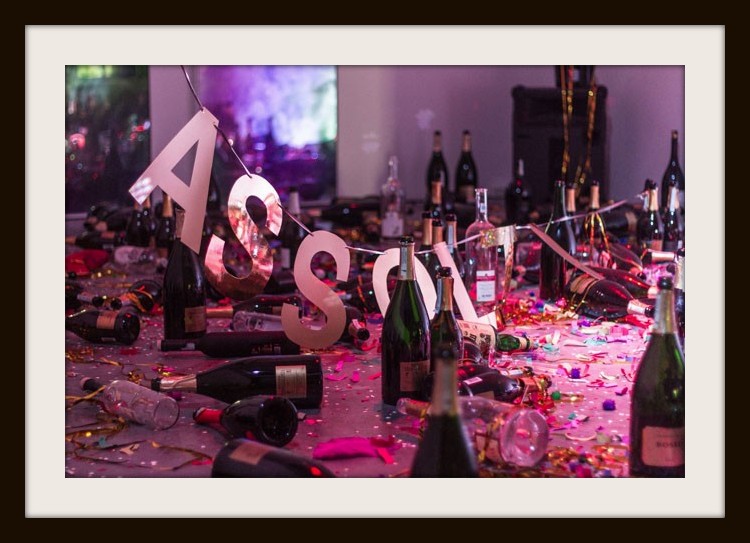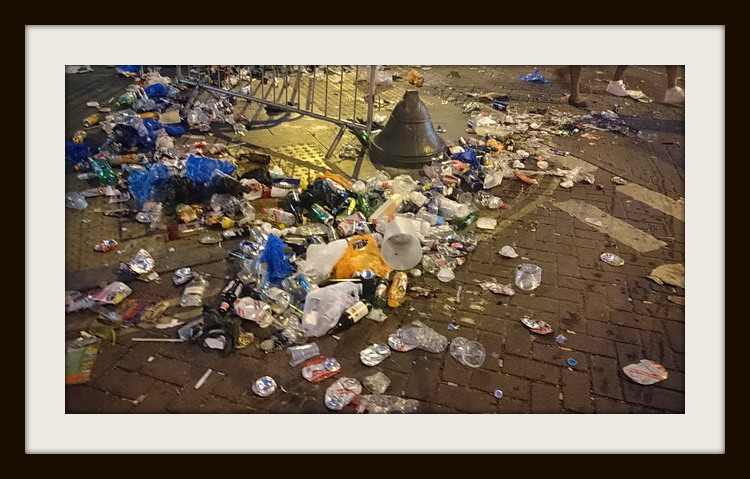Is Modern Art A Load Of Rubbish? Posted by Serena on Oct 29, 2015 in News
Geoff and I have a pet hate for the type of ‘intellectual’ modern art which needs a long pretentious statements posted next to it in order to distinguish it from any of the other banal everyday stuff that surrounds us. Unfortunately, a lot of modern art does seem to be simply intellectual rubbish … and sometimes it literally is rubbish.
So it’s not surprising that every now and then, so called ‘art installations’ are mistaken for pieces of garbage by a particularly diligent cleaning lady. Here’s an amusing article published in the on-line newspaper Urban Post last Monday:
Bolzano, donne delle pulizie scambiano opera d’arte per spazzatura e la buttano.
Bolzano, cleaning ladies mistake an artwork for rubbish and throw it away.
E’ questo il pericolo che corrono le opere d’arte moderne, forse spesso troppo astratte e di difficile comprensione. A Bolzano alcune donne delle pulizie, forse confuse dal tipo di opera che si sono trovate davanti, hanno gettato nella spazzatura un’installazione artistica, e in particolare ambientale, dal titolo “Dove andiamo a ballare questa sera?”
This is the danger run by modern art works, maybe because they’re often too abstract and difficult to interpret. In Bolzano some cleaning ladies, maybe confused by the kind of art work they found in front of them, threw an art installation into the rubbish, in this particular case an environmental piece entitled “Where shall we go to dance tonight?”
Spot the difference
Il museo di Bolzano, accortosi subito della mancanza, ha denunciato il fatto con un post su Facebook: “I precedenti illustri ci sono tutti, dalla Vasca di Joseph Beuys* alla porta di Duchamp. Questa mattina il personale addetto alle pulizie ha rimosso l’installazione ambientale ‘Dove andiamo a ballare questa sera?’ delle artiste Goldschmied & Chiari, recentemente inaugurata. L’opera, che mostrava i resti di una festa finita, verrà riallestita al più presto!”
The Bolzano museum, having immediately noticed its absence, announced the fact with a post on Facebook: “The precedents are all there, from Joseph Beuys’ Bathtub*, to Duchamp’s Door. This morning the cleaning staff removed the recently inaugurated environmental installation entitled ‘Where shall we go to dance tonight?’, by the artists Goldschmied & Chiari. The art work, which showed the remains of a party after it was over, will be set up again ASAP!”
Ma il museo di Bolzano, dal tono utilizzato sul social, sembra averla presa con leggerezza, per fortuna. L’opera d’arte era costituita da bottiglie, cicche di sigarette e coriandoli, che le donne delle pulizie hanno giustamente confuso con il baccano già presente nella sala, nella quale la sera precedente si era svolta una festa. Forse stavolta il fattaccio è anche comprensibile.
However, from the tone used on the social network, Bolzano museum seems, fortunately, to be taking it lightly. The art work consisted of bottles, cigarette butts, and confetti, which the cleaning ladies reasonably mistook for the mess already present in the hall where a party had been held the previous evening. Maybe this time the ugly incident is quite understandable.
Spot the difference
*In 1973 a piece of ‘art’ by the German conceptual artist Joseph Beuys called Badewanne (Bathtub), literally a tub filled with felt, grease and bandages, was pulled out of a room where it was stored for an upcoming exhibition and cleaned spotlessly by two unsuspecting cleaning ladies to be used to hold bottles of beer and glasses at a political party meeting.
Respect to cleaning ladies, who often seem to be the only ones able to tell art from rubbish!

Build vocabulary, practice pronunciation, and more with Transparent Language Online. Available anytime, anywhere, on any device.








Comments:
Joseph T. Madawela:
I guess I am in a time warp,My favorite is still Italian Renaissance art though I still like Klimt and S
chiele
Jillian:
Loved this article – and couldn’t agree more! What a discerning eye those cleaning ladies have. They should be promoted (or should that be demoted?) to art critics.
Geoff:
@Jillian Grazie Jillian, a presto, Geoff
Empias:
Amo questo sito. Un modo così divertente per imparare e praticare italiano. E gli autori sembrano essere divertirsi. Grazie!!
Geoff:
@Empias …. a voglia che ci divertiamo! Saluti da Geoff e Serena, gli autori 🙂
paolo:
Sì ma dipende dall’arte, non se è moderna. Su un livello, penso che l’arte ponga domande e noi forniamo le risposte. Una stanza pieno di spazzatura possa porre delle domande ma non sono così interessanti. E chi se ne frega cosa sono le risposte.
Su un altro livello, penso che l’aspetto e le estetiche dell’arte contribuiscano e potrebbero essere uguali con il significato o piuttosto i possibili significati in gran parte quando affrontando un’opera d’arte per la prima volta.
Qual è l’arte e qual è la spazzatura? Anche dipende dalla persona. Un altro problema è che gli specialisti e gli esperti spesso gravitano verso quello che produce “shock value” anche se l’arte si possiede una mancanza di merito artistico e nessuno non gli piace l’arte (tranne gli esperti oppure forse loro pensano che glielo piace e devono convincersi.)
Andrej:
Salve!
E’ così piacevole incontrare delle persone che pensano allo stesso modo. Per creare un’arte vera ci vogliono talento, anni d’esperienza e moltissimo lavoro. Per creare ciò che si vende facilmente oggi, basta a volte qualche ora. Ho tradotto per gli artisti e conosco questo piccolo mondo.
Saluti da Andrej
Kate:
Si.
Geoff:
@Kate Shortest reply ever!